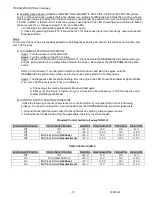
- 2 -
650014B
Additional Notes:
Wiring Information:
The wire connections that you will need to make into your vehicle are as follows
:
RED:
Connect to constant 12 volt source. This should go to the fused terminal that feeds power to the brake lights.
BROWN:
Connect to switched 12 volt source. This should be connected to an accessory terminal of the fuse panel
capable of supplying 10 amps. This wire should have 12 volts when the ignition key is in the accessory and
run positions, but not in the off or start positions.
BLACK:
Connect to a good ground point on the chassis or fire wall.
VIOLET:
Connect to cold side of brake light switch. This wire should have 12 volts only when the brake is depressed.
When the brake is not depressed it should be grounding through the brake light bulbs. If the brake light bulbs
are not connected or are burned out, the system will not operate.
LED brake lights will not provide proper
grounding
. If you have LED brake lights, use a relay as shown on page 3.
BLUE:
Connect to negative side of ignition coil. On GM HEI ignitions or MSD ignitions connect to TACH terminal.
Do not route the BLUE tach wire and GRAY speed wires along side each other. The tach wire can cause
interference with the speed signal wire.
GRAY: see following section on SPEED CONNECTION.
Throttle connection:
The Cruise Control installation manual provides detailed diagrams for connecting the servo to the throttle. These diagrams cover
basic OEM factory throttle hook-ups. It may be necessary to use a slight variation of one of the diagrams with aftermarket
carburetors.
Control switch:
There are various types of turn signal and dash mount control switches that are available. The type of control switch that we supply
with the cruise control is a closed circuit type for a turn signal handle control and open circuit for dash mount switches. If you will be
connecting to a factory GM 4 wire control switch, they are open circuit type. GM switches which do not have 4 wires are not
compatible with this cruise control. Ford cruise control switches are not compatible with this cruise control.
SPEED CONNECTION:
When using a cable drive speedometer, the metal, 8,000 pulse per mile, speed pulse generator is placed in line with the cable. This
can be done at either the transmission side or the speedometer side of the cable. The two wires from the sensor connect as
follows:
Systems with black and gray wires twisted together from the sensor:
BLACK wire to ground, GRAY wire from sensor harness to GRAY wire from cruise harness.
Systems with a gray cable with a red and black wire inside:
BLACK wire to ground, RED wire from sensor harness to GRAY wire from cruise harness.
When the cruise control is used with a Dakota Digital
STR3B, STR4B, STR5B, STR6B, STR3C, STR6C, STR5D, STR6D,
STR2000
display system the gray wire should be connected to the SPEED terminal on the display system control box. On the
VFD3, VFD3X or VHX
display systems, the gray wire should be connected to the 2K or SPD OUT terminal, (2K or 4K PPM signal),
on the display system control box
(please see VFD3/VHX instruction manual for changing between 2K and 4K).
When the cruise control is being installed into a newer vehicle which does not use a speedometer cable consult the Vehicle
Technical Information Guide supplied with the cruise. This will provide you with information on where to connect the gray wire.
SETTING PROGRAMMING SWITCHES:
Switch**
1
2
3
4
5
6
7
8
9
10
11
12
Application 1
ON
ON
ON
ON
*ON
Application 2
ON
ON
ON
*ON
Application 3
ON
ON
ON
ON
ON
*ON
* SW 12 will be OFF for
HND-2
applications
** all other switches to the OFF position
Application 1:
8cyl, Auto tranny,
STR series control box,
closed circuit control switch, 8K PPM pulse generator
Application 2:
8cyl, Auto tranny,
VFD3, VFD3X or VHX control box (2K OUT/ SPD OUT),
closed circuit control switch
Application 3:
8cyl, Auto tranny,
VDO 3-wire pulse generator,
closed circuit control switch
The description of the switch functions are found on page 6 of the Cruise manual. If you experience a surging when the cruise
control engages then turn switch number 1 off.
TROUBLE SHOOTING:
If the system fails to operate after making all of the proper connections, consult the self diagnostics procedure on page 16. The
Diagnostics LED is located beside the programming switches, under the rubber plug on the actuator.
In order for the cruise to regulate the speed properly, the car must be tested on the road and not with the tires elevated off the
ground.



































